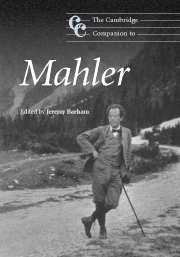Book contents
- Frontmatter
- Introduction: Marginalia on Mahler today
- PART ONE Cultural contexts
- PART TWO Mahler the creative musician
- 4 Juvenilia and early works: from the first song fragments to Das klagende Lied
- 5 Song and symphony (I). Lieder und Gesänge Volume 1, Lieder eines fahrenden Gesellen and the First Symphony: compositional patterns for the future
- 6 Song and song-symphony (I). Des Knaben Wunderhorn and the Second, Third and Fourth Symphonies: music of heaven and earth
- 7 Song and symphony (II). From Wunderhorn to Rückert and the middle-period symphonies: vocal and instrumental works for a new century
- 8 The ‘greatest’ and the ‘most personal’: the Eighth Symphony and Das Lied von der Erde
- 9 The last works
- PART THREE Mahler the re-creative musician
- PART FOUR Reception and performance
- Appendix: selected discography
- Notes
- Bibliography
- Index
8 - The ‘greatest’ and the ‘most personal’: the Eighth Symphony and Das Lied von der Erde
from PART TWO - Mahler the creative musician
Published online by Cambridge University Press: 28 September 2011
- Frontmatter
- Introduction: Marginalia on Mahler today
- PART ONE Cultural contexts
- PART TWO Mahler the creative musician
- 4 Juvenilia and early works: from the first song fragments to Das klagende Lied
- 5 Song and symphony (I). Lieder und Gesänge Volume 1, Lieder eines fahrenden Gesellen and the First Symphony: compositional patterns for the future
- 6 Song and song-symphony (I). Des Knaben Wunderhorn and the Second, Third and Fourth Symphonies: music of heaven and earth
- 7 Song and symphony (II). From Wunderhorn to Rückert and the middle-period symphonies: vocal and instrumental works for a new century
- 8 The ‘greatest’ and the ‘most personal’: the Eighth Symphony and Das Lied von der Erde
- 9 The last works
- PART THREE Mahler the re-creative musician
- PART FOUR Reception and performance
- Appendix: selected discography
- Notes
- Bibliography
- Index
Summary
The ‘greatest’ and the ‘most personal’
Whenever Mahler had completed preliminary work on a new composition he lost no time in letting friends and relatives know about it. Attributes he would thereby bestow on his works are revealing – and in such cases Mahler was certainly not sparing with superlatives. ‘It is the most significant thing I have done yet’ was for example his assessment of the Finale of the Second Symphony. He called the Third Symphony ‘my most individual and my richest work’. Whatever the degree of understandable enthusiasm resonating from such comments, it was rare for Mahler's judgements to be final. He appeared to sense each new composition as having reached a yet higher stage of development, successive completed symphonies always seeming his best to date.
There are only two notable exceptions to this. In order to express the aspirations and significance of the Eighth Symphony in words, during its composition in 1906 he wrote, ‘Just imagine the universe beginning to ring and resound. There are no longer human voices, but planets and suns circling above.’ He upheld the judgement that it was his ‘greatest’ work even when writing his important and substantial later works. At the beginning of October 1909, two months after the draft score of the Ninth Symphony had been completed, he called the Eighth ‘my most important work’, and in the summer of 1910 he spoke once more of his ‘greatest achievement’. Mahler bestowed a similarly positive, if subtly diering, attribute on the work which immediately followed: Das Lied von der Erde.
- Type
- Chapter
- Information
- The Cambridge Companion to Mahler , pp. 128 - 142Publisher: Cambridge University PressPrint publication year: 2007

